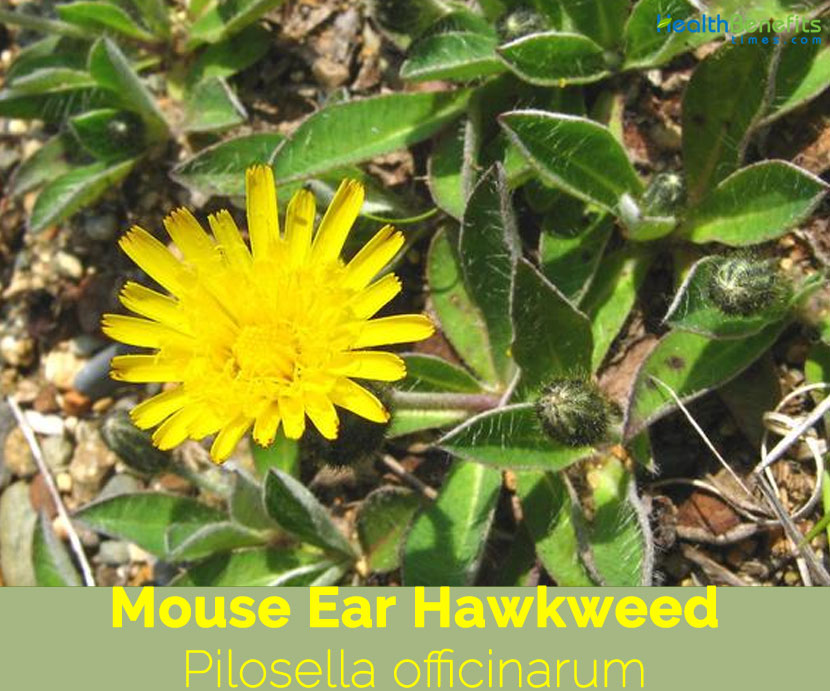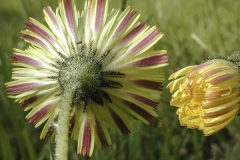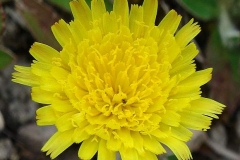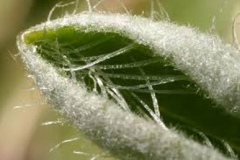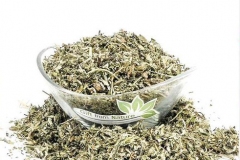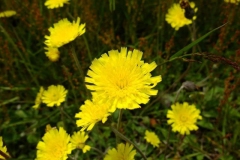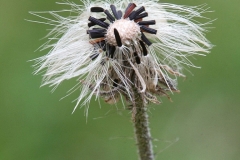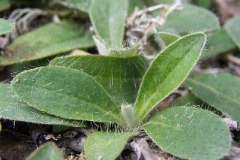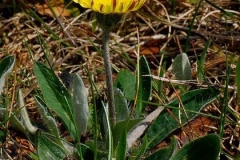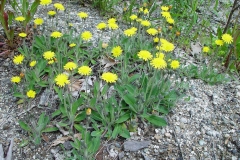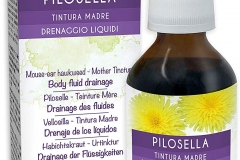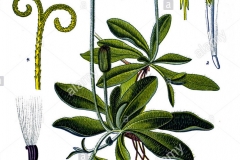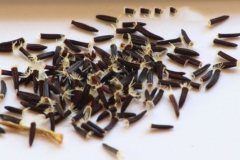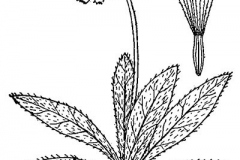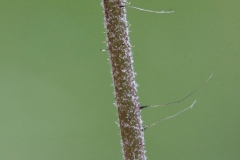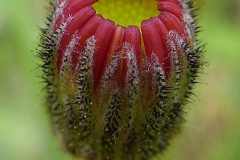| Mouse ear hawkweed Quick Facts | |
|---|---|
| Name: | Mouse ear hawkweed |
| Scientific Name: | Pilosella officinarum syn. Hieracium pilosella |
| Origin | Europe, western Asia and northern Asia |
| Colors | Purple-black |
| Shapes | Achenes with slender bristles about 1.5-2 mm long, narrowed at the base, and with a tawny pappus |
| Taste | Pungent |
| Health benefits | Beneficial for asthma, heal wounds, wheeziness, nosebleeds, whooping cough, bronchitis, liver diseases, hemorrhages, diarrhea and inflammation of the intestine, congested and chronic coughs, enteritis, influenza, pyelitis, cystitis, menstrual bleeding |
| Name | Mouse ear hawkweed |
|---|---|
| Scientific Name | Hieracium pilosella syn. Pilosella officinarum |
| Native | Europe (i.e. Denmark, Finland, Ireland, the UK, Norway, Sweden, Austria, Belgium, Czechoslovakia, Germany, Hungary, the Netherlands, Poland, Switzerland, Belarus, Estonia, Latvia, Lithuania, Moldova, Ukraine, western Russia, Albania, Bulgaria, Greece, Italy, Romania, Yugoslavia, France, Portugal and Spain), western Asia (i.e. Armenia, Azerbaijan and Georgia) and northern Asia (i.e. western Siberia) |
| Common Names | Hawkweed, mouse ear hawkweed, mouseear hawkweed, Felon Herb, Mouse-ear, Pilosella, mouse-eared hawkweed |
| Name in Other Languages | Albanian: Këmashna me pak lesh Austria: Kleines habichtskrau; langhaariges habichtskraut; mausohr-habichtskraut Basque: Bilorria, erabia-belarra, sagu-belarra Belarusian: Jastrabok valasisty (Ястрабок валасісты) Bulgarian: Vlaknesta rumyanka (влакнеста румянка), miši uši (миши уши) Catalan: Filosella, herba cancer, herba de Sant Joan, herba del mal blanc, herba luda, herba vellutada, orella de rata, pelosella, peludella, pilosella Croatian: Mala runjika Czech: Chlupáček zední, jestřábník chlupáček Danish: Håret høgeurt, Mus-øre Dutch: Muizenoor, muizeoor English: Mouse-ear hawkweed, Mouseear hawkweed, Hawkweed. Pilosella. Mouse Ear, mouse-eared hawkweed Estonian: Harilik karutubakas, karvane hunditubakas Finnish: Huopakeltano, Huopavoikeltano French: Herbe à l’épervier, oreille de rat, oreille de souris, piloselle, piloselle de rat, veluette, épervière officinale, épervière piloselle German: Gewöhnliches Habichtskraut, kleines Habichtskraut, langhaariges Habichtskraut, Mausohrhabichtskraut, Kleines Habichtskraut, Mausohr, Mausohr-Habichtskraut; Mausöhrlein Hungarian: Ezüstös hölgymál Irish: Searbh na muc Italian: Orecchio di topo, pelosella, sparviere pelosetto, pelosetta Latvian: Matainā pamauraga Lithuanian: Vienagraižė kudlė Netherlands: Muizeoor Norwegian: Mus-øre Northern Sami: Duobusfivli Occitan: Pelouso, Peludello Polish: Jastrzębiec kosmaczek Portuguese: Orelha-de-lebre, pilosela-das-boticas, piloselas Romanian: Vulturică Russian: yastrebinka volosistaya (ястребинка волосистая), yastrebinochka obyknovenna (ястребиночка обыкновенна) Serbian: Obična runjika (обична руњика) Slovak: Chlpánik lekársky, chlpánik obyčajný Slovene: Dolgodlakava škržolica, kosmatica Spanish: Achicoria, candelaria de los jardines, cepillo, cerrillejo, coca de Polonia, hierba de la salud, oreja de liebre, oreja de ratón, pelosilla, pelosilla mayor, pilosella, vellosilla, velosilla, árnica Swedish: Gråfibbla, vanlig gråfibbla Switzerland: Kleines habichtskraut, langhaariges habichtskraut, mausohr-habichtskraut, oreille de souris Turkish: Tırnakotu Welsh: Clust y llygoden |
| Plant Growth Habit | Prostrate, sprawling, hispid, monocarpic perennial herbaceous plant |
| Growing Climates | Upland pastures, meadows, heaths, banks, on walls, sheep-grazed grasslands, along roadsides, sparse bushes, in sunny pine and oak forests, gravel and clay pits, quarries, on fallow fields, tussock grasslands, lawns, wasteland, river terraces, rock outcrops, agricultural areas, dry prairies, railroads, and other disturbed sites |
| Soil | Grows well on sandy and similarly less fertile ground types, particularly in disturbed or waste areas |
| Plant Size | In between 15-30 cm tall and stolons can be 10-25 cm long |
| Root | Root system is comprised of fibrous roots and stolons |
| Stem | Erect, leafless, and unbranched, and sticky-hairy or somewhat wooly-hairy, mainly near the base |
| Leaf | Elliptic, 3-10 cm long, 1-5-2 cm in width, with distinctive white midvein. The lower leaf surface is covered with a dense layer of stellate hairs, and long, simple eglandular hairs cover both upper and lower leaf surfaces and the leaf margin |
| Flowering season | May to August |
| Flower | Flowering stem (scape) is generally between 5–50 centimetres (2.0–19.7 in) tall, and sprouts from the center of the basal rosette. The flower heads are borne singly on the scape and are a pale lemon-yellow color, with the outermost ligules having a reddish underside |
| Fruit Shape & Size | Achenes with slender bristles about 1.5-2 mm long, narrowed at the base, and with a tawny pappus |
| Fruit Color | Purple-black |
| Seed | Seeds are purplish black, short, columnar with many white bristles (pappus) on one end of the seed which act like a parachute as the wind distributes the seed |
| Propagation | Stolons, rhizomes and seeds |
| Taste | Pungent |
| Plant Parts Used | Aerial parts |
| Season | November – April – (May) |
| Precautions |
|
Plant Description
Mouse ear hawkweed is a prostrate, sprawling, hispid, monocarpic perennial herbaceous plant that normally grows between 15-30 cm tall and stolons can be 10-25 cm long. The plant is found growing in upland pastures, meadows, heaths, banks, on walls, sheep-grazed grasslands, along roadsides, sparse bushes, in sunny pine and oak forests, gravel and clay pits, quarries, on fallow fields, tussock grasslands, lawns, wasteland, river terraces, rock outcrops, agricultural areas, dry prairies, railroads, and other disturbed sites. It grows well on sandy and similarly less fertile ground types, mostly in disturbed or waste areas. Mouse-ear is a creeping herb that usually grows like a carpet on crawling runners, every one of which takes the form of a basal rosette of oval-shaped leaves. The root system is comprised of fibrous roots and stolons. The stolons can generate a new rosette at their extremity; each rosette has the possibility of developing into a new clone forming dense mats in open space. Stems are erect, leafless, and unbranched, and sticky-hairy or somewhat wooly-hairy, mainly near the base.
Leaves
Leaves are all basal except for the occasional scale-like leaf along the flowering stem. Basal leaves are 1 to 4 inches long, 1/3 to ¾ inch wide, generally elliptic, widest at or above the middle, blunt or pointed at the tip, tapering to wedge-shaped at the base, and toothless. The upper surface is sparsely to moderately cover in spreading hairs 1/8 to ¼+ inch long, the lower surface is white from a dense covering of shorter, star-shaped hairs mixed with long, spreading hairs. Flower stalks are long, leafless, and covered in stiff dark hairs. Leaves of the stolons are small and narrowly elliptic.
Flowers
The flowering stem (scape) sprouts from the center of the basal rosette. It is usually much taller than the leaves. The plant normally consists of a single flower, occasionally 2 or 3, at the tip of a hairy, leafless stem. Flowers are yellow, dandelion-like, ¾ to 1 inch across with up to 120 petals (ray flowers), the outer rays often with a red stripe on the back side.
The bracts (phyllaries) surrounding the base of the flower are in 1 or 2 layers, lance-linear, tapering to a pointed tip, and densely covered in a mix of blackish glandular and non-glandular hairs and long, white, bristly hairs. Flower stalks are also covered in a mix of blackish glandular and non-glandular hairs, and long, white, bristly hairs. Flowers open daily at 8 a.m. and close about 2 p.m. Flowering normally takes place in between May to August.
Fruit
Fertile flowers are followed by achenes with slender bristles about 1.5-2 mm long, narrowed at the base, and with a tawny pappus. Fruits can be found purple to black with off white hairs that are 0.2 in. (5 mm) long. The fruit are usually dispersed by the wind.
Traditional uses and benefits of Mouse ear hawkweed
- Mouse-ear hawkweed relaxes the muscles of the bronchial tubes, stimulates the cough reflex and reduces the production of catarrh.
- The herb is effective against respiratory problems including asthma, wheeziness, whooping cough, bronchitis and other congested and chronic coughs.
- Herb is mildly astringent, cholagogue, diaphoretic, strongly diuretic, expectorant and tonic.
- The fresh plant is antibiotic.
- The herb is also taken in the treatment of enteritis, influenza, pyelitis and cystitis.
- It is occasionally used externally in the treatment of small wounds and cuts.
- Its remedy is stated to relax the muscles of the bronchial tubes, reduce catarrh production and stimulate the cough reflex.
- Plant is an effective treatment for swelling caused by water retention, especially in the legs and lower part of the body.
- It is occasionally applied to wounds, and to ease inflammation in the kidneys and urinary tract.
- Mouse-ear hawkweed relaxes the muscles of the bronchial tubes, stimulates the cough reflex, and reduces the production of mucus.
- Tea prepared from the plant’s leaves was used to cure liver diseases, diarrhea and inflammation of the intestine.
- Mouse-ear found its place in herbal medicine in the form of a remedial agent to reduce fever.
- Powder prepared from the dried out herb was used to stop nosebleeds.
- The herb calms the muscles of the bronchial tubes, encourages the cough impulse and, at the same time, lowers mucus production.
- Mouse-ear is also used to treat excessive menstrual bleeding as well as to provide relief in case a patient is coughing up blood.
- This tea may be used in the form of a gargle as well as a skin wash or salve.
- Mouse-ear has been used internally as well as externally for treating hemorrhages.
- Infusion prepared from the herb was administered to treat cystitis.
- Mouse-ear may be applied as a poultice to hasten the healing of wounds if applied topically.
- Tea brewed from its small hairy oblong leaves supposedly cures liver ailments, intestinal inflammations, and diarrhea.
https://www.youtube.com/watch?v=F2RtBUFDsNE
Recommended Infusion and Tincture
Medicinally, mouse-ear is used in the form of an infusion as well as a tincture.
Infusion: To prepare the infusion from mouse-ear add one to two teaspoonful of the dehydrated herb in a cup (250 ml) of boiling water and allow it to permeate for about 10 to 15 minutes. For optimum results, this infusion ought to be drunk three times daily.
Tincture: The tincture prepared from mouse-ear ought to be taken in dosage of 1 ml to 4 ml three times every day.
Mouse-ear is generally gathered between the period of May and June when the plants are in flowering season.
Prevention and Control
Due to the variable regulations around (de)registration of pesticides, your national list of registered pesticides or relevant authority should be consulted to control which products are legally allowed for use in your country when considering chemical control. Pesticides should always be used in a lawful manner, consistent with the product’s label.
Cultural Control
The main method of control at present is to improve pasture land by application of fertilizer and over sowing with pasture species. However, species of Hieracium/Pilosella remain a problem on areas of limited potential economic development, abandoned land, reserves and national parks. Timely over sowing and top dressing combined with intensive grazing show promise for control. Makepeace et al. discovered that of all the plant species investigated, clover is the best competitor. Where perennial grasses, legumes, and other beneficial forbs are present in the plant community, fertilizers can help control Hieracium/Pilosella species by increasing the competitive ability of more desirable species.
Mechanical Control
Due to its low, mat-forming growth, mowing is not effective. Mechanical control is ineffective since small fragments of plants can root and form new populations. In addition, plants or plant parts can be accidentally transported by machinery and establish elsewhere.
Chemical Control
Species of Hieracium/Pilosella have proved resistant to most herbicides, so that chemical control of the weed does not appear practical. P. officinarum can be controlled with 2, 4-D amine or ester, and a mecoprop + MCPA + dicamba formulation, although results have been variable. This variability in effectiveness was thought to be related to the time of application. The 2, 4-D ester usually yielded better results than the amine formulation. However, total kill is unlikely and follow up with fertilizer and top dressing is considered essential. A problem with chemical control is that the chemicals have as much, or more, impact on many desirable pasture species than they do on P. officinarum. In many areas in New Zealand chemical control is uneconomic and thus not considered on a large scale.
Biological Control
Since chemical and mechanical control methods are ineffective and/or not economical, a program to develop biological control with insects and a pathogen was initiated in 1992. P. officinarum is not attacked to any noticeable degree by phytophagous insects in New Zealand, therefore presenting a competitive advantage over native rangeland species. The rust fungus Puccinia hieracii var. piloselloidarum was chosen as a potential biological control agent. However, during the investigations prior to its introduction, it was detected in the field in New Zealand but further strains may need to be tested and released to infect the various biotypes of P. officinarum. In addition to this rust fungus, five herbivorous insects of European origin, Oxyptilus pilosellae (Lepidoptera, Pterophoridae), Aulacidea subterminalis (Hymenoptera, Cynipidae), Macrolabis pilosellae (Diptera, Cecidomyiidae) Cheilosia Urbana (Diptera, Syrphidae) and Cheilosia psilophthalma (Hymenoptera, Syrphidae) were studied and are approved for release in New Zealand. The insects attack different parts of the plant and are at least genus-specific.
Integrated Control
All risks which predispose short-tussock grasslands to P. officinarum invasion should be minimized. Instead, emphasis should be placed on sound land management including adequate fertilizing, avoidance of heavy grazing and burning, rabbit control, sowing of competitive pasture species, controlled grazing in the absence of P. officinarum flower heads and the use of classical biological control agents which stress or even kill P. officinarum.
Other Facts
- It is also a good bee and butterfly plant.
- It is used as food source for stock, soil conservation, horticultural plants, pollen source for honey production, suppression of other weeds and seed for herbal purposes.
- It is a known allopathic plant, whose roots secrete several substances inhibiting root growth, including its own.
- Flower open daily in the morning and close in the early afternoon.
References:
https://www.itis.gov/servlet/SingleRpt/SingleRpt?search_topic=TSN&search_value=37720#null
https://pfaf.org/user/Plant.aspx?LatinName=Pilosella+officinarum
http://www.floracatalana.net/hieracium-pilosella-l-
https://en.wikipedia.org/wiki/Pilosella_officinarum
https://gringlobal.irri.org/gringlobal/taxonomydetail.aspx?id=104350
https://gd.eppo.int/taxon/HIEPI
https://www.cabi.org/isc/datasheet/27162
https://www.botanical.com/botanical/mgmh/h/hawmou08.html
https://plants.usda.gov/core/profile?symbol=HIPI
http://issg.org/database/species/ecology.asp?si=1640&fr=1&sts=&lang=EN
http://www.theplantlist.org/tpl1.1/record/gcc-25499
https://wiki.bugwood.org/Hieracium_pilosella
https://www.minnesotawildflowers.info/flower/mouse-ear-hawkweed


